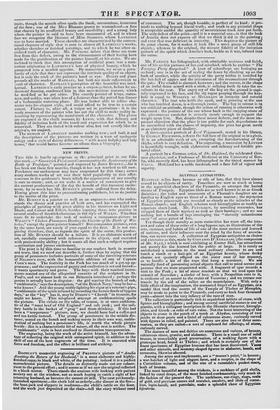FINE ARTS.
ANOTHER PICTURE-BOOK.
Si,- Thomas Lawrence's Cabinet of Gems is the title of a handsome quarto volume, got up in the style of an "Annual ;" consisting of a dozen fac-similes of °ketches by Sir THOMAS LAWRENCE, principally of his relatives, accompanied with descriptions, interwoven with some memorials of the painter's life and character, by P. G. PATMORE. The sketches include a three-quarter length portrait of the father of LAWRENCE—a portly person with a comely face of indolent jollity, crowned with a bob-wig; a head of his mother, taken just before her death, but expressing the masculine sense and energy of her character in the noble-featured face; Lady Hamilton, in an affected attitude, that gives an appearance of artificiality to her real beauty; several single heads and groups of children, amongst which are likenesses of his nephews and nieces, the Bloxams—graceful studies of infancy ; the eyes full of life and meaning, as they always are in LAWILENCE'S pot- traits, though the mouth often spoils the frank, unconscious, innocence of the face; one of the Miss Bloxams grown to womanhood—a face that charms by its unaffected beauty and sensibility ; and a young lady whom the painter is said to have been enamoured of, and in whose face we recognize the likeness of Miss SIDDONS, whom LAWRENCE was to have married. These sketches are characterized by the conven- tional elegance of style that is seen in almost all LAWRENCE'S works, whether sketches or finished paintings, and to which he too often sa- crificed truth of character. Mr. PATMORE infers that these are more free from this defect, owing to the circumstance of their having been made for the gratification of the painter himself, or his sister. We are inclined to think that this assumption of artificial grace was a man- nerism originating in LAWRENCE'S love of physical beauty, which lie pampered into a morbid appetite. By mannerism, we mean a pecu. liarity of style that does not represent the intrinsic quality of an object, but is only the trick of the painter's hand or eye. Beauty and grace pervade all the works of RAPHAEL, but both are made subservient to truth of character. RAPHAEL'S perception of the beautiful was intel- lectual. LAWRENCE'S early practice as a crayon-painter, before he un- derstood drawing, confirmed him in this mere triciuus manner, which he mod:fled as he got older. The courtly painter of kings, states- men, and nobles, was often less of a flatterer, than the petted boy-limner of a fashionable watering-place. He was better able to infuse cha- racter into his elegant style, and could afford to be true to a certain extent. Flattery is, after all, a vulgar art in portraiture : it is the ready resource of the painter who has not the skill to make reality in- teresting by representing the moral truth of the character. The plates are engraved in the chalk manner, by Lswis, with that delicacy and fidelity of imitation both of the touch and expression for which he is renowned. They are tinted with colour also, but not exactly like the origira's, we suspect. The memoir of LAWRENCE contains nothing new ; and both it and the descriptions of the pictures are written in a tone of apologetic eulogy and a style of dainty diffuseness, " with many holyday and lady terms," that would better become an album than a biography.



























 Previous page
Previous page